Tomato "Mikado" loved by summer residents with a rich palette of subspecies and strong immunity - we grow ourselves without hassle
When choosing a tomato variety, most gardeners pay attention to parameters such as disease resistance and unpretentious care. After all, it is these characteristics that determine how easy it will be to grow tomatoes.
One of the varieties that will delight both novice gardeners and experimental farmers is the Mikado tomato. It has gained popularity with gardeners all over the world.
The content of the article
General description of Mikado
The variety is presented in several varieties., which differ in the color of the fruit. Among them there are both plants with classic red and pink berries, and more exotic - black-fruited tomatoes. For more than a decade, Mikado tomato seeds have been grown in different regions of our country.
Note! Mikado is a variety. The seeds from its fruits are used for planting. They are collected from berries ripened on the bush, washed from the pulp, dried and stored in clothes bags.

Distinctive features of varieties
The main advantage of the variety - large fruits with a rich sweet taste and an abundance of pulp. Another advantage of such tomatoes is their high immunity. Mikado is not afraid of most tomato diseases, including late blight.
The Mikado group includes several tomato varieties... They have similar characteristics and differ in fruit color:
- Mikado golden... Produces yellow fruits. Contains an increased concentration of beta-carotene and lycopene. Improves vision, speeds up metabolism and has antioxidant properties. Rarely cause allergies.
- Mikado pink... It has pink fruits, which are characterized by a high content of vitamin C and selenium. Such berries help to increase immunity and improve brain activity.
- Mikado red... Increased serotonin content. Improves mood, removes bad cholesterol and free radicals from the body.
- Mikado black... The fruits are burgundy in color with brown and dark purple spots. This color is due to the presence of anthocyanin. It is a strong antioxidant that not only removes harmful substances from the body, but also improves the condition of the heart and blood vessels.
Mikado also has cons... This variety is susceptible to temperature extremes. If it is too hot outside, the fruits will crack. At low temperatures, plants simply stop growing.
Main characteristics
All Mikado varieties have almost the same characteristics.... Only the color of the fruit differs:
| Parameter | Indicators |
| Bush type | Indeterminate variety. The height varies between 1.5–2 m. In the greenhouse, the plants are taller. The stems are thick and strong. Bushes are medium leafy. The dark green leaves are large, potato-like. The first inflorescence is formed in the axil of 8-9 leaves. |
| Growing method | Tomatoes of this variety are grown both outdoors and in greenhouses in central and southern Russia. In the northern regions, tomatoes are grown in greenhouses. |
| Yield | Average. From 1 sq. m collect up to 8 kg of berries. |
| Fruit | Large. The weight of one berry varies between 300-700 g. The shape is round, strongly flattened at the base.There is a pronounced ribbing. The taste is rich sweet, with barely noticeable sourness. There is a lot of pulp, it is juicy and tender. The variety is characterized by multi-chamber. The color of the berries depends on the type of variety. There are pink, yellow, red and burgundy with dark spots Mikado. The color of the shell matches the color of the pulp. |
| Transportability | Low. The fruits are easily damaged during transportation. |
| Ripening terms | Pink Mikado is early ripe, its berries ripen 95-100 days after sowing the seeds. Black, golden and red Mikado are mid-season, their fruits ripen 110-115 days after sowing the seeds. Fruiting continues until the end of August. |
| Disease resistance | It is immune to all tomato diseases. |
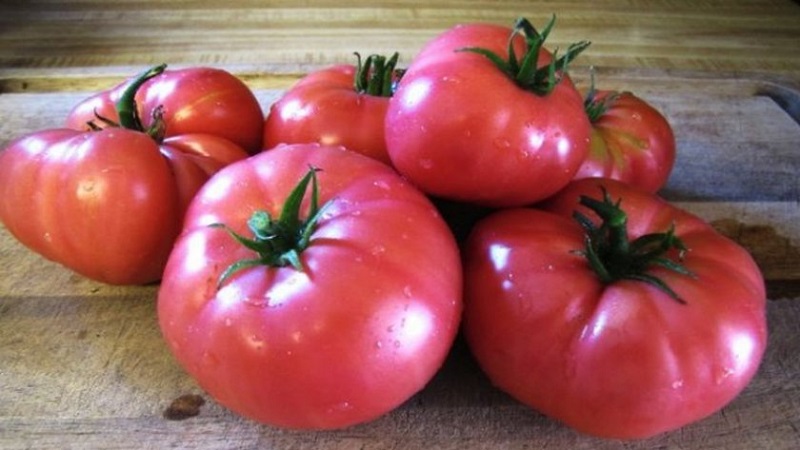
Growing seedlings
Mikado Tomatoes grown in seedlings... Otherwise, the fruits simply do not have time to ripen before the onset of cold weather.
Seed sowing time depends from the region and from the conditions in which they are going to be planted:
- in the southern regions, seedlings are sown in late February or early March;
- in the central zone - in the second half of March;
- in cities with cold climates - in early April.
If you plan to grow tomatoes in a greenhouse, the seeds are sown 14 days earlier. Experienced gardeners recommend checking the timing of the work with the indicators of the lunar calendar.
Read also:
Tomato "Pink Impression" and the nuances of its cultivation
Seed treatment
Seeds must be processed before planting. The preparation of planting material includes the following steps:
- Germination test. The seeds are soaked in salted water for 30 minutes. Surfacing planting material is considered unsuitable for planting. Instances that have sunk to the bottom will rise.
- For disinfection, they are soaked in a light pink solution of potassium permanganate or in hydrogen peroxide for 20 minutes, then washed.
- Growth stimulation. Planting material is soaked in "Epin", "Zircon" or "Sodium humate".
Note! Disinfection and seed stimulation are sometimes combined. To do this, they are soaked for a day in a solution of soda (1 teaspoon of soda per 1 tbsp. Of water) or in aloe juice, diluted in half with water.
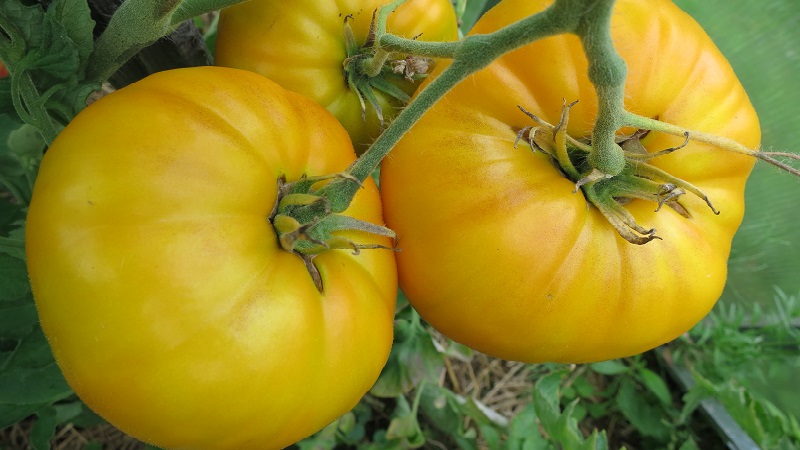
Preparation of containers and soil
For sowing seeds usually use one large common container... Gardening stores sell special boxes and trays. You can use cut bottles, disposable bowls, cake and convenience food packaging.
Tomatoes dive into separate containers... It is most convenient to use peat pots, from which you do not need to extract seedlings when transplanting. Plastic cups and cut-off bottles of at least 300 ml will also work. Drainage holes are made at the bottom of homemade seedling containers. They are usually already in store-bought pots.
Containers for growing seedlings need to be disinfected - soak in a solution of potassium permanganate for half an hour or pour boiling water over.
Advice! If you plan to plant several bushes of Mikado tomatoes, then it is more convenient to use peat tablets. In this case, the seedlings do not need a pick.
Tomato soil is sold in the store... For seedlings, a universal tomato and pepper mixture is suitable. To prepare the soil yourself, mix the nutrient substrate with the base and baking powder. For example, take in equal proportions turf, humus and sand. The soil is also disinfected. It is calcined in the oven, poured with boiling water or a solution of potassium permanganate.
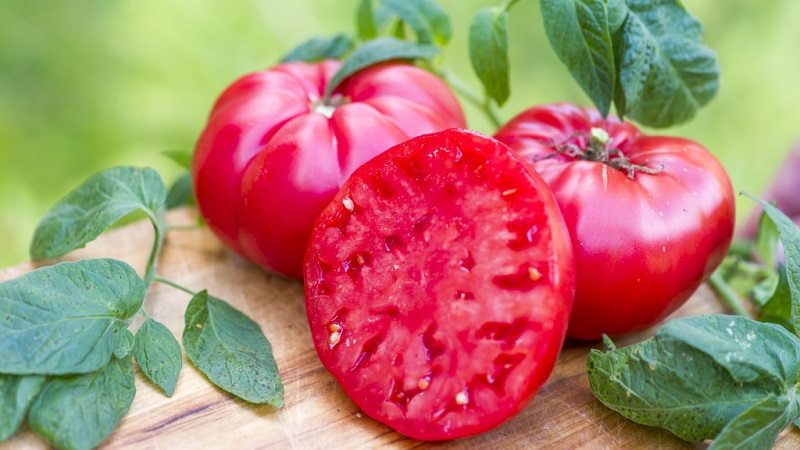
Seed sowing methods
Seeds are sown for seedlings in different ways. Here are the most popular:
- In a common box. The container is filled with soil so that 3 cm is left to the edge. The soil is watered. Seeds are spread on it in rows, keeping a distance of 2 cm between each specimen. A centimeter layer of earth is poured on top. Boxes with seeds are covered with foil and put away in a warm place.Plants dive into individual cups after the appearance of two real leaves.
- In peat tablets. The blanks are folded into one container with the hole down and filled with hot water. When the liquid is absorbed, it is added again. Swollen peat bags are removed from the container. One seed is planted in each of them. The tablets are placed in a common container, covered with foil and removed to a warm place. Seedlings are not dived until disembarking at a permanent place.
- Without land. At the bottom of a deep container, lay out several layers of paper napkins or gauze, which are moistened with water. Seeds are placed on them. From above, the planting material is covered with several more layers of paper, which is also watered. Cover with foil and put in a warm place. When the seeds germinate and cotyledon leaves appear on them, they are planted in individual pots.
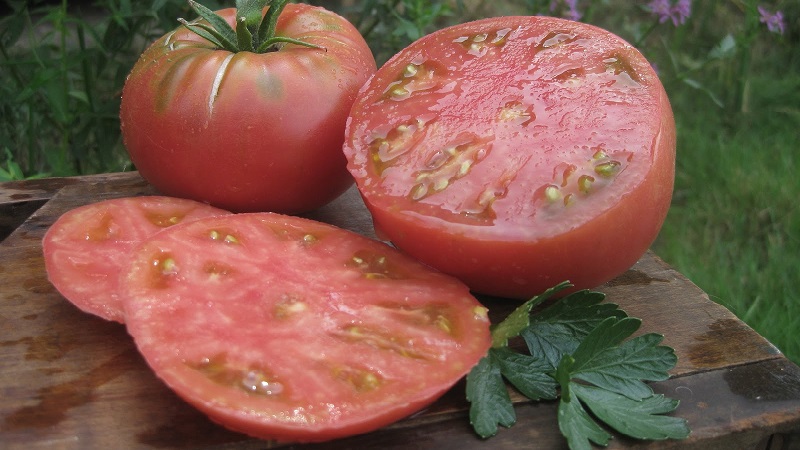
Seedling care
Good quality seedlings are sturdy, stocky plants with short internodes and bright green foliage. To get such tomatoes, it is important to take proper care of them:
- After seed germination, the film is not removed for another week. Moreover, every day it is opened for several hours, airing the sprouts.
- Then the seedlings are transferred to a room with a temperature of +17 ° C. The plants are kept there for a week, after which they are brought back into the room.
- Water the seedlings as the soil dries. The water should be at room temperature. It is important to avoid getting moisture on the ground part of the plants. Young tomatoes should not be poured or overdried. In both cases, they will die.
- After the pick, the tomatoes are not fed or watered for two weeks.
- For the entire period of growing seedlings, tomatoes are fed three times. The first one two weeks after the pick into individual containers, then two more times with an interval of two weeks. Complex formulations including phosphorus are used as dressings.
- 14 days before planting the seedlings in a permanent place, they begin to harden it. For this, plants are exposed on the street or on the balcony during the warm season. Quenching starts from half an hour, gradually bringing the time to 16 hours.

Agrotechnics of Mikado tomatoes
Outdoor tomatoes planted when the soil temperature at a depth of 15 cm reaches +16 ° С... By this time, the age of the bushes should be from 55 to 60 days. Three days before planting, plants are watered and fed - this will help to quickly cope with stress.
And more about tomatoes:
Picking to a permanent place
Tomato is a light-loving plant. His planted in the most illuminated area garden. Mikado is most sensitive to lack of light. In such conditions, he begins to hurt and does not set fruit.
Tomatoes must not be preceded by other nightshade crops... Choose areas of the garden where legumes or melons were previously cultivated. In autumn, the soil is prepared. It is dug to the depth of a shovel bayonet and cleaned of plant debris. Then add 4 kg of humus per 1 sq. m. If the acidity of the soil is increased, ash or dry lime is added to it. In the spring, the beds are leveled with a rake and cleared of weeds.
The holes are dug in rows in a checkerboard pattern... For 1 sq. m place 3-4 plants. 1 tbsp is poured into the holes. l ash or dry granular fertilizers of long duration. Then 1 liter of water is poured into each recess.
A plant is placed in the hole along with a lump of earth. If the tomatoes were grown in peat pots or tablets, then the container is not removed during planting, but destroyed from several sides. After that, the bushes are covered with soil, which is compacted.

Basic rules of care
Tomato Mikado tied to wooden supports or tapestries with synthetic thread. Heavy fruits should also be attached to the support.
Form the plant into one or two stems... The more stalks remain, the smaller the fruits will be and the later the harvest will ripen. In the process of pinching, it is important to remove leaves at the bottom of the stem, yellowed and wilted greens. This is done once a week, getting rid of no more than three leaves in one procedure.
Water the plants as the soil dries... The water should be settled and warm. If the liquid gets on the ground part of the bush, burns will appear on the leaves. After each watering, the soil is loosened - it is impossible to allow the formation of an earthen crust, which interferes with normal root air exchange. In the process of loosening, weeds are removed. Do this while the weeds are still fresh. Otherwise, weeding will damage the tomato roots.
Top dressing is applied four times per season... They alternate between complex mineral and organic. Foliar fertilizers are applied twice. Use means containing boron. They will speed up the formation of ovaries.
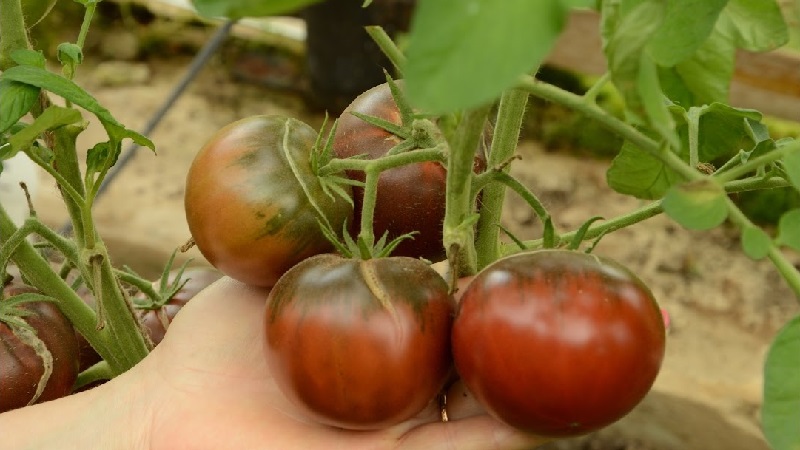
What you need to know to get a good harvest
When growing tomatoes, it is important to follow the basic rules for caring for them. Also, gardeners should familiarize themselves with the nuances.that will help you get a bountiful harvest:
- On the day of pinching, tomatoes are not watered. Moistening the soil during this period will increase the likelihood of plant disease.
- Stepson and water the tomatoes when the sun is not active. The best time is early morning or evening.
- Tomato bushes are shaken regularly to stimulate pollination.
- In order not to waste time on moistening the soil, many gardeners install a drip irrigation system.
- Deformed inflorescences are removed. Low-quality fruits grow from them.
Diseases and pests
The Mikado cultivar is highly immune to major tomato diseases. He is not even afraid of late blight. Nevertheless, prevention rules should be followed:
- All garden tools that will come into contact with the beds are disinfected. The garden soil and greenhouse walls are also disinfected. For this, copper sulfate is used.
- For the prevention of diseases, tomatoes are sprayed with a light pink solution of potassium permanganate.
- To protect plants from small pests, plantings are sprayed with celandine broth. Eggshells buried in the holes help from the bear.
- Large beetles are collected by hand.
The nuances of growing in open and closed ground

Tomato Mikado grown in greenhouses and in the open field... There are several nuances that are important to consider when using these methods. In the greenhouse, diseases spread faster and there is increased humidity. The solution to these problems is simple - regularly ventilate the room.
To speed up pollination, experienced gardeners recommend putting a fan in the greenhouse. The walls of the room must be treated with a disinfectant.
In the open field, the beds are watered 2-3 times a week depending on weather conditions. Only one watering is required in a greenhouse.
After planting seedlings in open ground for the first two weeks, it is covered overnight with a film to protect the plants from frost.
Harvesting and application of the crop
Mikado is harvested in July... The fruits are plucked piece by piece, keeping the stalk. This way they will last longer.
Harvest Mikado used for fresh consumption... Tomato sauces and juice are prepared from it. In general, tomatoes of this variety are not canned.
Advantages and disadvantages of the variety

Benefits of Mikado:
- large-fruited;
- rich color palette of fruits;
- rich sweet taste;
- the possibility of growing in open and protected ground;
- immunity to tomato diseases.
Disadvantages of the variety:
- the need for garter and pinching;
- susceptibility to temperature extremes;
- low transportability.
Farmers reviews
Farmer reviews of Mikado tomatoes are mostly positive... The fruits of this variety are as large and beautiful as in the photo.
Irina, Sochi: “I have been growing Mikado for over 10 years.I tried all varieties of this variety. The black ones are most popular, as they are the sweetest. Golden Mikado is the most beautiful. Tomato rarely gets sick, even when grown outdoors ".
Alexander, Ryazan: “The Mikado tomato is my favorite variety. Loved it because of the large and sweet fruits. The largest tomato of this variety, which I managed to get, weighed 680 g. I form bushes into one stem, so the fruits are larger. ".
Conclusion
Mikado is a variety for gardeners who want to grow large tomatoes of unusual colors, but do not want to risk it. The berries of these tomatoes have a rich sweet taste and juicy soft pulp. Growing Mikado is not difficult, the main thing is to provide the bushes with regular feeding and a comfortable temperature.
The fruits are eaten fresh, added to the first and second courses. Not suitable for whole-fruit preservation. The resistance of the variety to diseases and large-fruited make it popular among gardeners.